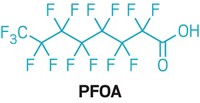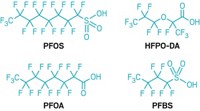Advertisement
Grab your lab coat. Let's get started
Welcome!
Welcome!
Create an account below to get 6 C&EN articles per month, receive newsletters and more - all free.
It seems this is your first time logging in online. Please enter the following information to continue.
As an ACS member you automatically get access to this site. All we need is few more details to create your reading experience.
Not you? Sign in with a different account.
Not you? Sign in with a different account.
ERROR 1
ERROR 1
ERROR 2
ERROR 2
ERROR 2
ERROR 2
ERROR 2
Password and Confirm password must match.
If you have an ACS member number, please enter it here so we can link this account to your membership. (optional)
ERROR 2
ACS values your privacy. By submitting your information, you are gaining access to C&EN and subscribing to our weekly newsletter. We use the information you provide to make your reading experience better, and we will never sell your data to third party members.
Chemical Regulation
US PFAS makers will have to control releases to water
EPA to set wastewater discharge limits for these chemicals
by Cheryl Hogue
September 9, 2021
| A version of this story appeared in
Volume 99, Issue 33

US plants that manufacture per- and polyfluoroalkyl substances (PFAS) will soon have to control their releases of these “forever chemicals” in wastewater, the US Environmental Protection Agency says.
Currently, the EPA has no limits for PFAS in industrial wastewater discharged to public sewage treatment plants or directly into rivers, lakes, and other surface waters.
Valued for their toughness as well as their grease and water resistance in a wide variety of applications, PFAS are synthetic chemicals that are highly resistant to breaking down in the environment. Some PFAS are linked to developmental problems, cancer, and other adverse health issues.
Environmental advocates have called for the EPA to set legally enforceable, federal discharge standards for PFAS under the Clean Water Act. Meanwhile, water utilities have become increasingly concerned that the EPA will set health-based limits on PFAS allowed in drinking water—leaving them and their customers stuck with the costs of removing the pollutants while industrial releases remain unregulated.
“For the first time, EPA is committing to limit PFAS in wastewater discharges,” the EPA’s assistant administrator for the Office of Water, Radhika Fox, said in announcing the plans Sept. 8.
The agency will establish limits for these chemicals in wastewater released from PFAS producers in the organic chemical, plastics, and synthetic fiber industries. In addition, the EPA says it will set similar discharge limits for chromium electroplating facilities that use and release PFAS.
Rep. Chris Pappas (D-NH), who cosponsored PFAS control legislation (H.R. 2467) passed by the House of Representatives in July, is calling for the agency to do more.
“The EPA should expand these regulations to other known industries that are actively discharging these forever chemicals,” Pappas says in a statement.
PFAS manufacturers have time to prepare for the planned discharge limits. Generally, it takes the EPA 3 years or more to craft and finalize regulations.
The American Chemistry Council, a chemical industry association, says in an emailed statement that it backs "development of effluent guidelines for industry sectors that release those PFAS that can be reliably measured and have been determined to present a human/environmental health concern." The trade group opposes regulating PFAS as a class because of their variety of physical, chemical, and biological properties.
UPDATE
This story was updated on Sept. 10, 2021, to add a statement from the American Chemistry Council.








Join the conversation
Contact the reporter
Submit a Letter to the Editor for publication
Engage with us on Twitter